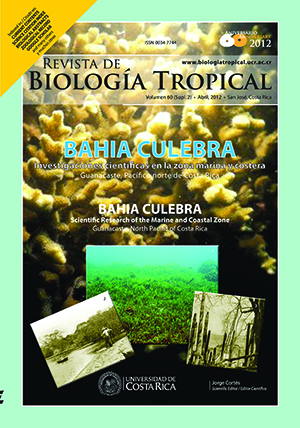Resumen
Los arrecifes coralinos son uno de los ecosistemas más diversos en el planeta, tanto por los organismos constructores como por aquellos que viven encima, sobre, dentro y debajo de ellos. Los corales del género Pocillopora son reconocidos mundialmente por albergar una importante fauna de invertebrados entre sus ramas, los cuales son considerados como simbiontes obligatorios en una gran cantidad de casos. La presente investigación describe la fauna de invertebrados asociados al coral Pocillopora damicornis en Bahía Culebra, Costa Rica, describiendo sus densidades, frecuencias, riquezas y diversidades a través del tiempo. Para esto se colectaron 5 colonias cada 3-4 meses en Playa Blanca, Bahía Culebra. En total se encontraron 448 individuos en 35 especies, siendo Harpiliopsis depressa, Lithophaga aristata, Trapezia ferruginea, Alpheus lottini, Fennera chacei, y Petrolisthes haigae las especies predominantes. Noviembre fue el mes en el que se encontraron los mayores valores en los índices de riqueza, diversidad y diferenciación taxonómica, mientras que agosto fue el que presentó los valores más bajos de todos. En términos generales, la época lluviosa mostró mayor riqueza de especies que la época seca. Así mismo, las especies colectados y los valores obtenidos son muy similares a otras zonas del Pacífico Oriental Tropical. Culebra ha venido sufriendo una pérdida en la cobertura coralina, que podría tener consecuencias en la diversidad y abundancia de organismos asociados a corales. Estas consecuencias incluyen pérdida en la fecundidad de estos organismos, una reducción en su función como limpiadores y protectores de depredadores del coral, poniendo en riesgo su diversidad, lo que puede afectar los stocks de peces depredadores que depende de ellos. Realizar monitoreos permanentes de la criptofauna asociada al coral Pocillopora va a ser determinante para cuantificar pérdidas o recuperaciones en la composición de invertebrados asociados, y por ende en las funciones que estos desempeñan en este ecosistema.Comentarios
Descargas
Los datos de descargas todavía no están disponibles.






